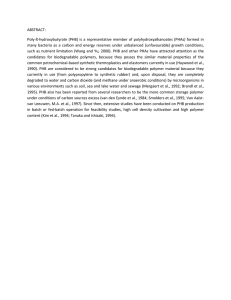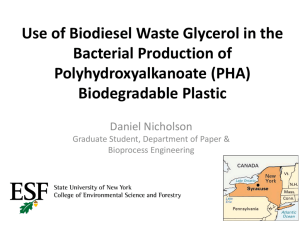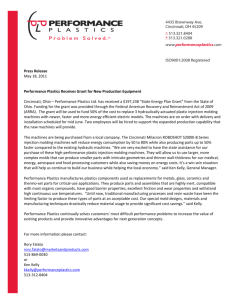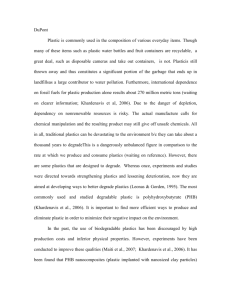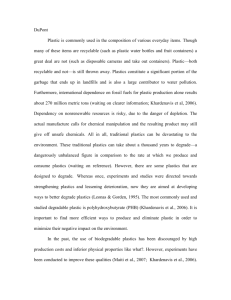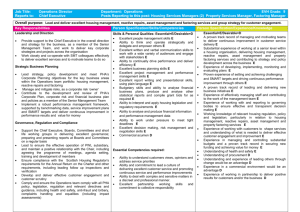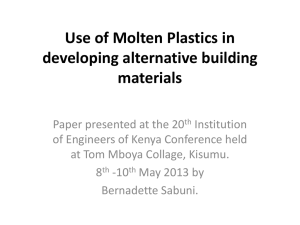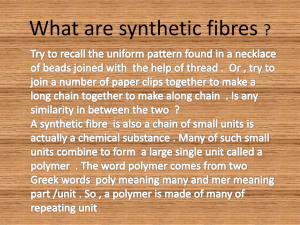lecture
advertisement
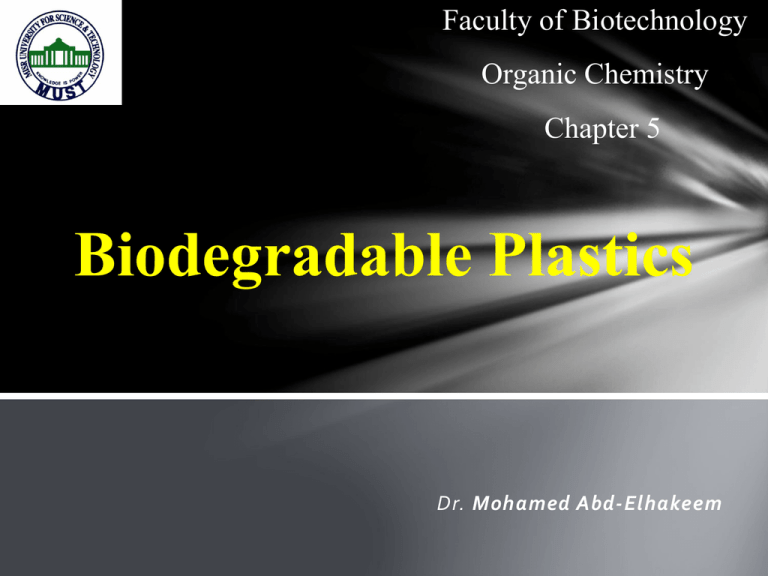
Faculty of Biotechnology Organic Chemistry Chapter 5 Biodegradable Plastics Dr. Mohamed Abd-Elhakeem A plastic material is any of a wide range of synthetic or semi-synthetic organic polymer Plastics important to a range of industries, including aerospace, building and construction, electronics, packaging, and transportation. Some plastic products But The plastics industry uses large amounts of energy. The manufacturing of conventional plastics uses substantial amounts of toxic chemicals. Plastic litter disfigures the oceans and the coastlines. Ingestion of plastic kills marine creatures and fish. Plastics use valuable resources of oil. one common property is the high resistance to natural degradation processes. The fact that the plastics are mostly non-degradable is the primary cause of still increasing amount of solid waste 1- Prepare materials of such resistance and quality that could be used for a very long time and therefore they will not create waste in high amount. 2- Prepare plastics that are recyclable, i.e. usable repeatedly. 3- Prepare plastics that are easily degradable, i.e. biodegradable the third strategy embodies the right choice e.g. for the one-use daily-used things. Many of the living systems (mainly plants and microorganisms) are producing materials with a great potential of replacing the synthetic polymers prepared mainly from oil. One of the typical groups of materials that one can easily find in the nature is Polyhydroxyalkanoates (PHA) Polyhydroxybutyrate Polyhydroxyalkanoates or PHAs are linear polyesters produced in nature by bacterial fermentation of sugar or lipids. They are produced by the bacteria to store carbon and energy. Biosynthesis PHA are synthesized and intracellular accumulated in most bacteria a under unfavorable growth condition such as limitation of nitrogen, phosphorus, oxygen or magnesium in the presence of excess supply of carbon source The stored PHA can be degraded by intracellular depolymerases and metabolized as carbon and energy source as soon as the supply of the limiting nutrient is restored The yield of PHA obtained from the intracellular inclusions can be as high as 80% of the organism's dry weight. PHA Production PHAs are accumulated in the cells as discrete granules, the size and number per cell varies depending on the different species. about 8 to 13 granules per cell having diameter range of 0.2 to 0.5μm were observed in Alcaligenes eutrophus. Transmission electron micrograph of thin sections of recombinant R. eutropha PHB cells containing large amounts of PHB Extraction • The dry cells were blended with chloroform using the high speed homogenizer. • The supernatant was then filtered through the filter paper. • The remaining solution was concentrated by rotary evaporator. • PHB was then precipitated by dropping the viscous solution into 10 volume of 95% ethanol. PHA BIODEGRADABILITY • Microorganisms colonize on the surface of the polymer and secrete enzymes which degrade P(HB-HV) into HB and HV units. These units are then used up by the cell as a carbon source for biomass growth. • The rate of polymer biodegradation depends on a variety of factors, including • 1- microbial activity of the disposal environment • 2-pH, temperature, moisture and the pressure of other nutrient materials. P(HB-HV) is water insoluble and is not affected by moisture, does not degrade under normal conditions of storage, in air The end products of PHA degradation in aerobic environments are carbon dioxide and water, while methane is also produced in anaerobic conditions The effect of different environments on the degradation rate of PHB and P(HB-HV) has been studied by several worker Degradation occurs most rapidly in anaerobic sewage and slowest in seawater. P(HBHV) completely degraded after 6, 75 and 350 weeks in anaerobic sewage, soil and sea water, respectively. Applications 1. Packaging : P(HB-HV) could be used for films, and bottles. 2. Medical : P(HB-HV) biocompatibility coupled with its slow hydrolytic degradation lead to potential in reconstructive surgery. END of the Course Best wishes
